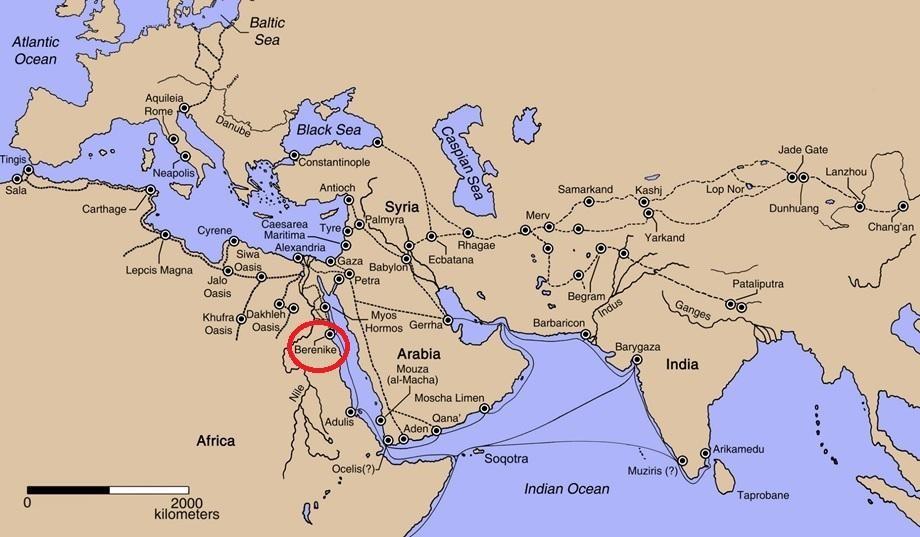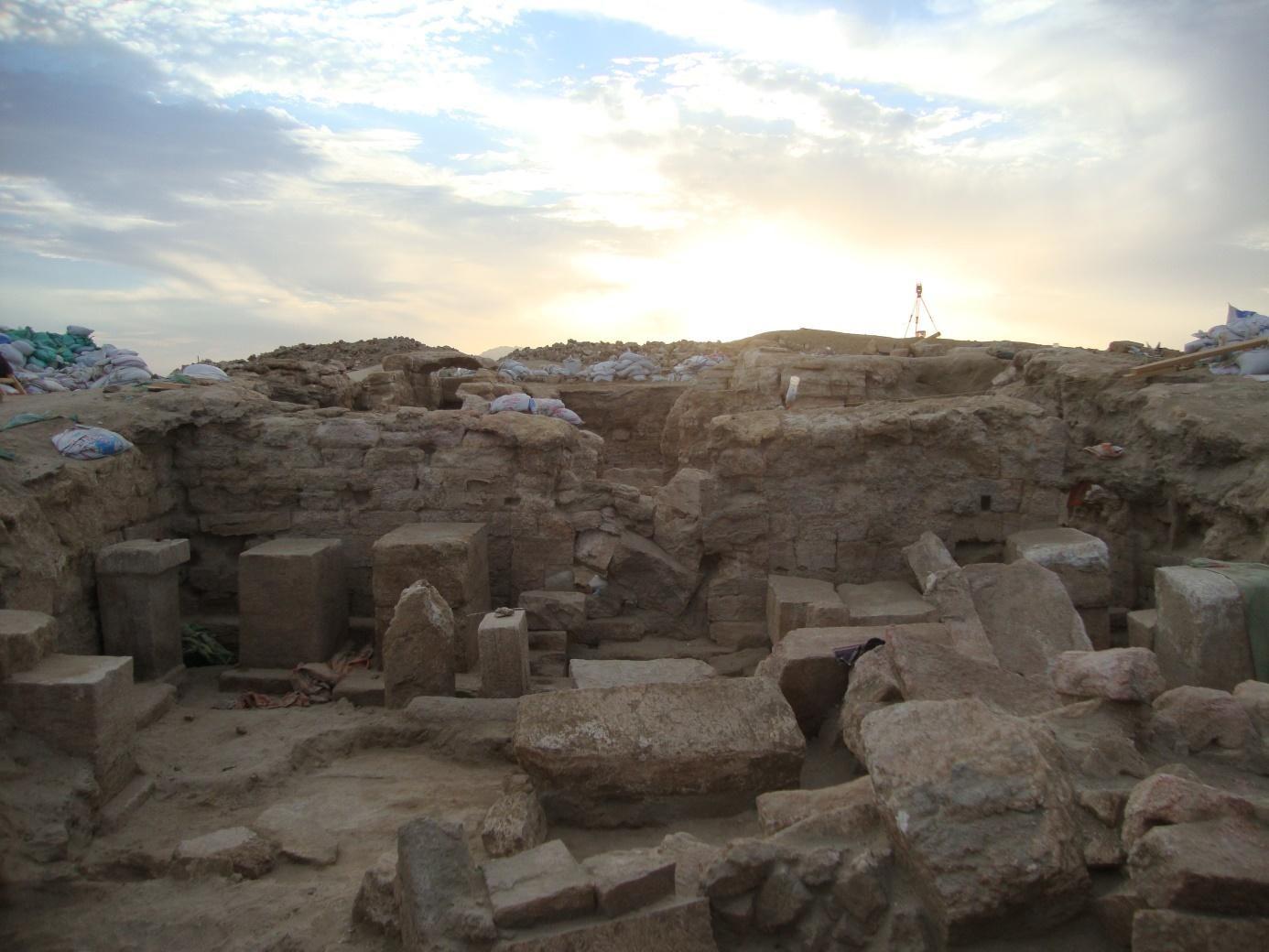Roderick C.A. Geerts (Leiden University)
Ports are places where people, objects, ideas and cultures meet. They are more than just a hub where commodities get exchanged, shipped and stored. The facilities meet those essential demands for the tasks conducted, nonetheless the people living and working there create the hubbub and liveliness. Besides the practical facilities for the cargo, there are facilities to accommodate the merchants, sailors and traders. This is as true today as it was in the past. Excavations can teach us much about the use and life at ports in the past. Each year an international team of researchers from all over the world investigates an ancient port in Egypt. The Red Sea port of Berenike has been excavated since the mid 90’s and at present a team from the Universities of Delaware, Heidelberg, Leiden and the Polish Center of Mediterranean Archaeology (PCMA) in Warsaw is conducting the research. Ancient ports like Berenike are well connected to large parts of the known world; they are real cosmopolitan ports and operate within extensive networks, evidence thereof will be presented below.

Berenike is situated on the Red Sea coast in the South of Egypt. The site was chosen for its natural sheltered bay, with the Ras Benas peninsula protecting the harbour and ships, and providing calm waters. Berenike was in operation for about 800 years, from the 3rd century BCE until the 6th century CE. During the centuries BCE it was a port that provided the Ptolemies (the ruling dynasty of Egypt) with much needed elephants for warfare. The port declined during the first century BCE. In the first six centuries of the common era, it was part of the Roman Empire, an Empire that spanned the entire Mediterranean coast and large parts of Northwest Europe. The port of Berenike was reestablished to increase the trade within the Indian Ocean basin and mainly to acquire spices, like pepper. Evidence for the trade in spices comes from antique sources like the mid-first century AD Periplus Maris Erythraei (a travel guide-like document that lists port and coastal landmarks in the Red Sea and Indian Ocean), texts on the site and actual vessels with remains of spices found at Berenike. With these commodities many traders made their way to Berenike.

Which traders frequented the ancient port can only be discerned from what is found on the site itself. This evidence ranges from the commodities to their personal belongings and activities they partook in. Commodities found on the site are for instance a transport vessel from India with 7.55 kg of black pepper in it. According to ancient sources black pepper was relatively affordable. Other exotic botanical products, and animals have been found on the site, Abyssinian pea, coconut and mung beans, rice being some of the examples thereof (Cappers 2006). However, to differentiate personal belongings from commodities based on archaeological evidence is difficult. Through time objects get dispersed and have been degraded by time and weather, and personal belongings are not always marked to differentiate from similar objects owned by others or commodities. In general commodities should be unused until they reach their destination. In light of that, many of the ceramics from Axum Eritrea (Axum), the Arabian peninsula and India could be seen as personal belongings. Foreign merchants could have cooked their meals in cooking pots brought from home. Cooking vessels and plates from many countries have been used in the port showing the international community living there. For other objects like jewelry and textiles the distinction is even less clear as their use wear can be less evident, especially on fragments. Further evidence of the possibility of usage of exotic objects by traders is found in the presence of texts and inscriptions on the site. There are as many as twelve languages attested (Sidebotham 2011). Many of those languages originate in the Indian Ocean basin. Some of these texts clearly mention that traders were present at Berenike. One of the inscriptions mentions the merchant Marcus Laelius Cosmus, during the reign of emperor Tiberius (14-37 CE), who was involved in the spice trade in Berenike and the Indian Ocean Basin. He or a relative might be mentioned in texts of the Roman poet Martial (ca. 38-104 CE), which therefore could indicate the direct involvement of dignitaries from the capital, Rome, in the ancient spice trade (Ast 2021).
Many other inscriptions have been found in the site's central Isis Temple as well. Temples of Isis and Serapis are commonly found in ports across the Roman Empire; examples are known from Alexandria, Pompeii and Ostia, Rome’s harbour. These gods were the ones to pray for a safe voyage on the ocean and promises were made to them to dedicate statues upon a safe return. It is therefore logical that in the Isis Temple of Berenike many dedications are found related to the spice trade and seaborne travels. Ongoing excavations since 2015 have focussed on the temple and uncovered most of it and its courtyards. The courtyards are the only parts of the temple that was not restricted to the priests. They were the places where people venerated the gods with dedicatory offerings of inscriptions, statues, etc. Along the temple façade and courtyard walls many fragments of those have been found, which give a great deal of information on the merchants present at Berenike, their trade and where they came from. These dedications were mostly executed in Greek; the lingua franca in this part of the Roman Empire. However, some were made in other languages by travelers from abroad (Sidebotham et al. in prep). This makes the cosmopolitan character of Berenike clearer. Merchants from all over the Indian Ocean Basin frequented the site in order to trade their commodities and the Isis Temple was used by whoever wanted to receive blessings for a safe return. All finds and evidence uncovered clearly shows the site and the level of connectivity going on in the Indian Ocean trade networks. It is not only people travelling to faraway ports, but the objects and commodities travel much further. Black pepper from India passes Berenike and ends up in the Netherlands, while Italian amphorae with wine end up in India and some gems travel further to Thailand and beyond.
This short overview of finds from the ancient port of Berenike show that there is much information to be found under the sands of the desert, an arid land that still holds many secrets and amazing finds. Many discoveries await us and the archaeological research continues on the site. The main aim of the project is to understand the Indian Ocean trade better, to unravel the life in a busy port city and to put the site and finds in the broader perspective of connectivity.
Acknowledgements
This blog has been written in the context of discussions in the LDE PortCityFutures research community. It reflects the evolving thoughts of the authors and expresses the discussions between researchers on the socio-economic, spatial and cultural questions surrounding port city relationships. Special thanks for comments and reviews to Steve Sidebotham, Rodney Ast coordinators of the Berenike project and Carola Hein, Foteini Tsigoni and Vincent Baptist.
Bibliography
R. Ast, “Marcus Laelius Cosmus. Italian merchants and Roman trade at Berenike under the Julio-Claudian emperors”, in Merchants, Measures and Money. Understanding technologies of Early Trade in a Comparative Perspective, eds. L. Rahmstorf, G. Barjamovic & N. Ialongo (Kiel/Hamburg, 2021), Weight & Value 2, 141-157.
R.T.J. Cappers, Roman Foodprints at Berenike. Archaeobotanical evidence of subsistence and trade in the Eastern Desert of Egypt (Los Angeles, 2006), Berenike Report 6 / Cotsen Institute of Archaeology Monograph 55.
S.E. Sidebotham, Berenike and the Ancient Maritime Spice Route (Berkeley & Los Angeles, 2011), California World History Library 18.
S.E. Sidebotham, R. Ast, O.E. Kaper, M. Bergmann, S. Bhandare, A. Maurer, R. Hartmann, S. Popławski, J.M. Oleksiak, N. Bartos, R.C.A. Geerts, R. Kucharczyk & M. Castro, “Results of the Winter 2022 Excavation Season at Berenike (Red Sea Coast), Egypt”, Thetis. Mannheimer Beiträge zur Archäologie und Geschichte der antiken Mittelmeerkulturen (in preparation).
